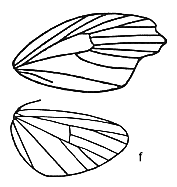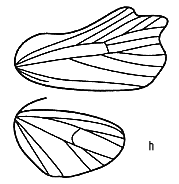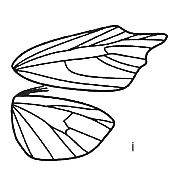|
Macaduma
Walker
Type
species: tortricella Walker, Java.
This
and the next two genera appear to be related. All have the forewing irregularly
shaped (Figs 4f, h, i), with an angle or strong arching on the costa, and a
protrusion on the distal margin: at the terminal branching of the Rs system in Oxacme
Hampson and Tortricosia Hampson, but in the medial sector in Macaduma.
All veins arising from the forewing cell are present in the first two
genera, but the radial sector branching system is reduced to two in some Macaduma
(e.g. the type species) from three (this is (R3 (R4, R5)) as in Utriculofera).
Tortricosia has M3 stalked with CuA1. In the hindwing, all have Rs and M1
stalked, but the more posterior veins vary: M2 is lost in Tortricosia,
with M3 and CuA1 stalked; M3 and CuA1 are totally fused (or one lost) in Oxacme
(and also Utriculofera); all veins are present in Macaduma, with M3 and CuAl stalked.

Fig 4f: Macaduma
tortricella Walker
|

Fig 4h: Tortricosia
excisa Hampson
|

Fig 4i: Oxacme
dissimilis Hampson |
The
male abdomen of all three has complex corematous structures; these are on
segments 3 to 6 in Macaduma (Fig 152)
and on 6 to 8 (sometimes also 5 in Oxacme)
in the other two genera. The male genitalia of Macaduma have a
number of distinctive features: the uncus broadens towards the apex, shaped
somewhat as in a parang or machete, though apically acute; the valves appear
undivided, but this may be through reduction of the dorsal portion at the
expense of the saccular process, and bilaterally asymmetric. All three genera
have the characteristically twisted, lobed appearance of the paratergal
sclerites at the junction of tegumen and vinculum on each side that has its
greatest development in the Garudinia generic
complex, and the ductus ejaculatorius of the aedeagus is often sclerotised as in
that group.

The
female genitalia of Macaduma (tortricella)
have a scobinate signum and a prominent appendix bursae, whereas those of
the other two have the bursa more generally spined.
Macaduma
has its
greatest diversity in the Australian tropics, particularly New Guinea, extending
weakly east to New Caledonia, Fiji and Samoa (Holloway, 1979) and west to the
Himalaya (the type species, though material included in the BMNH series,
extending through the Indo-Australia tropics, needs revision through dissection;
specimens from Bali were examined in the course of this work). One new species
occurs in Borneo.
<<Back
>>Forward <<Return
to Contents page
|




